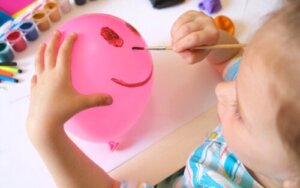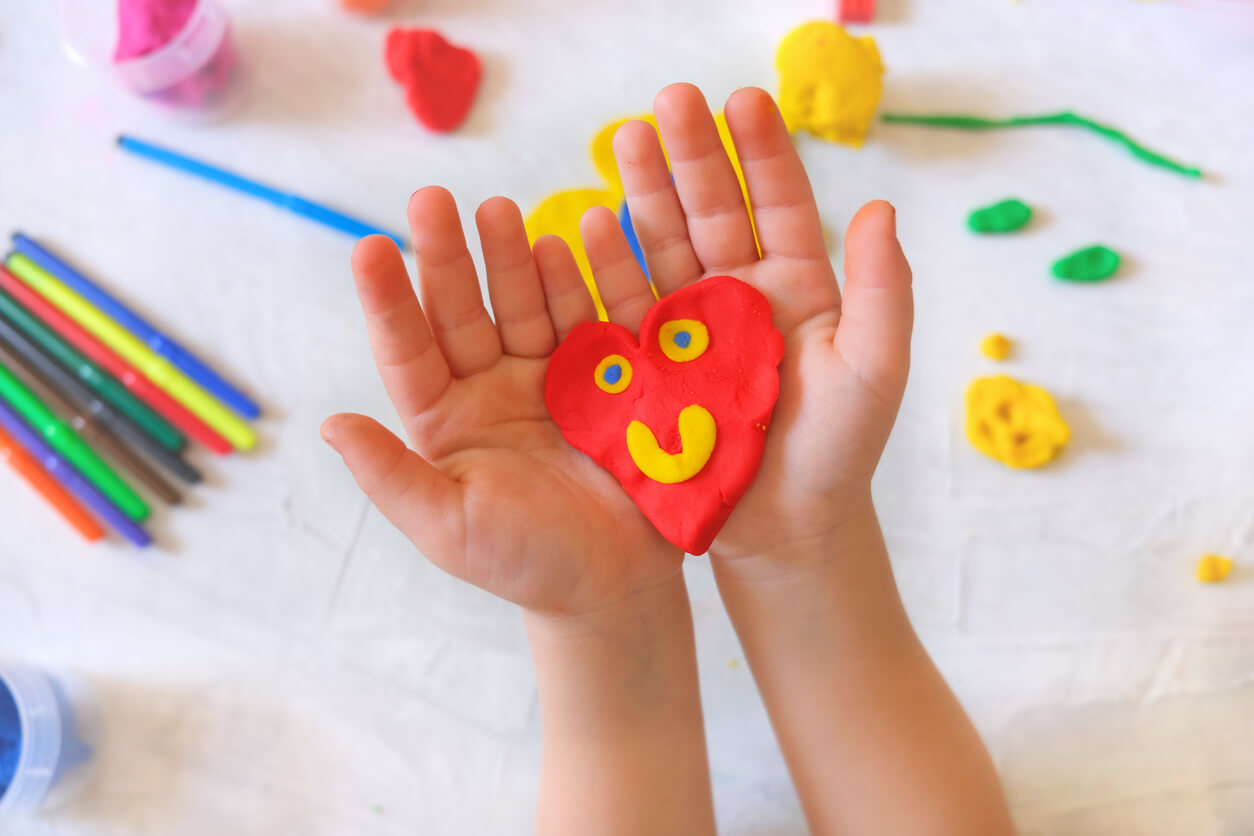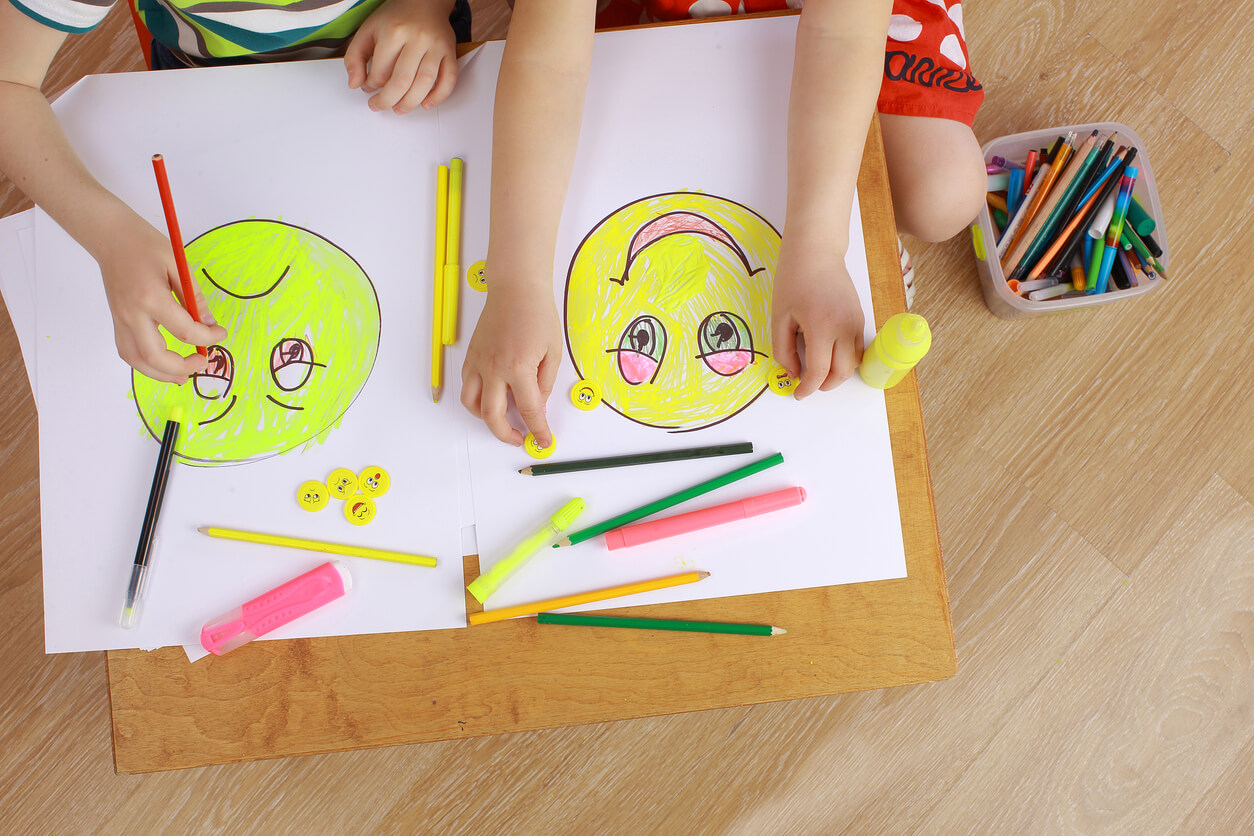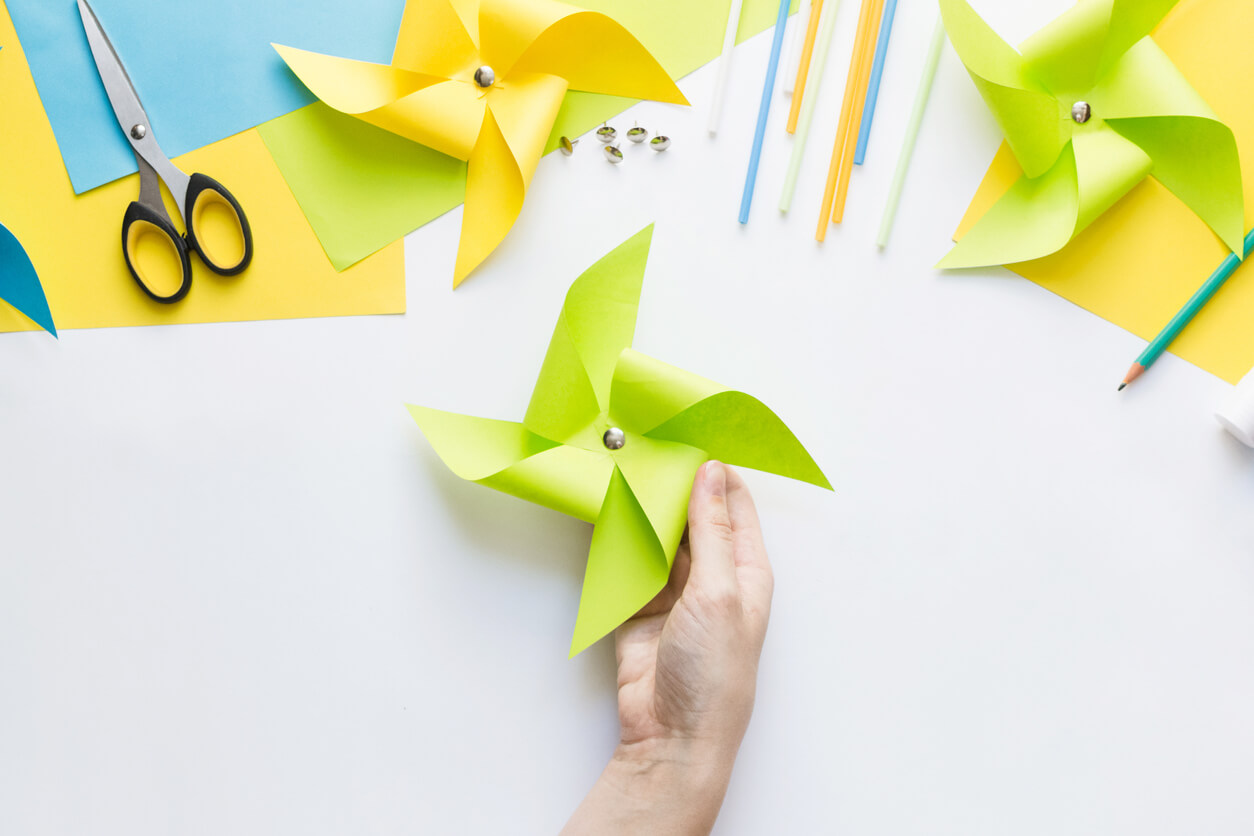5 Crafts to Work on Emotional Intelligence

One way to teach children to identify emotions, both their own and those of others, is through crafts to work on emotional intelligence.
In the first years of life, motor, cognitive, and communication skills are developed. At the same time, social skills are learned and feelings and emotions are discovered. The latter, according to research by the Center for Child Development at Harvard University, are part of the normal brain architecture, but their evolution is greatly influenced by the environment.
For this reason, both parents and teachers can do a lot to work on emotional intelligence in children. Either through the incorporation of reading stories, audiovisual resources, and also, certain crafts that allow them to understand what emotions are and how they’re expressed.
Below, we’ll share some craft projects of this type that are easy, fun, and simple. You’ll see that children will be able to make them with elements they have at home, without having to spend a lot of money.
Let’s get to work!
Joy, sadness, anger: How to shape emotions with children’s hands
Have you ever thought about how your hands influence the regulation of your emotions? Then try these crafts with your little ones and you’ll discover the answer.
1. Clay faces

Modeling clay is an ideal material to use with the little ones, as it’s easy to use, wash, and store. Plus, children love it!
Materials you’ll need
- Colored modeling clay
- Something to poke with, such as a wooden skewer
- Cardboard
Step by step instructions
- Mold the clay into different face shapes: Round, oval, triangular. You can also choose by color, such as red for an angry face or yellow for a happy face.
- Mark the eyes and mouth with the different expressions using the skewer.
- Place the faces on the cardboard and teach the children the names of each emotion.
2. Spring of emotions
When the season of flowers is approaching, we can plan a craft to work on emotional intelligence. This task is ideal to carry out with children who already know how to write and read.
Materials you’ll need
- Colored construction paper
- Pencil for drawing
- Stencils with flower shapes
Step-by-step instructions
- Find and print out flower stencils with petals.
- Transfer the shapes to the colored cards and cut them out in parts.
- Talk about the emotions and write their name on each petal.
- Assemble the flowers and give your home a spring decoration!
3. Drawing and painting emotions
The plastic arts are recognized as one of the best ways to express and recognize all kinds of feelings and emotions in oneself and others.
Materials you’ll need
- Watercolors or colored tempera
- A black pencil
- White paper
Step-by-step instructions
- Suggest a theme for the children to develop freely. It can be a family, a house, or faces.
- When they finish, open a group discussion to interpret the emotions of each drawing. For example, why did you paint mom with that face? What does it mean?

4. Face masks
Theatrical performance is an effective way to learn to recognize emotions. It’s also a fantastic vehicle for expression.
Materials you’ll need
- Printed templates of emojis
- Cardboard
- Glue
- Wooden pallets
Step-by-step instructions
- Print emojis about 9 inches in diameter and with different faces: Sadness, anger, joy, fear, and surprise.
- Glue the face on the cardboard and cut it out.
- Attach the wooden palette to the back side to assemble the faces.
5. Windmills for managing emotions
Learning to breathe is great for managing emotions, which is why this craft is so interesting.
When children blow on the windmill, they can check whether they do it in a calm or agitated way, how they feel at that moment, and how much energy they consume in each case.
Materials you’ll need
- Colored construction paper
- A black pencil
- A ruler
- Scissors
- Thick cardboard
- A brad
Step-by-step instructions
- Draw on the cardboard a square of 9 inches on each side and cut it out.
- Mark four diagonals from the tips to the center and cut, leaving a space in the center.
- Bring the ends to the center and glue them together.
- Cut the thick cardboard into a paddle shape, about 1.5 inches wide by 9 inches long.
- To finish, make a hole in the middle of the flower, push a brad through, and attach the cardboard paddle.

The benefits of crafts to work on emotional intelligence
Education is evolving day by day, and one of the topics that has been incorporated into the teaching-learning process is the development of emotional intelligence. In early childhood education, one of the ways to address the theme of emotions is through manual activities. This provides children with many benefits, such as the following:
- It helps them to express emotions in a playful way.
- Encourages the development of fine motor skills, while creating a space for learning and sharing.
- Contributes to the identification of emotions, such as joy, anger, sadness, and surprise, among others.
- It allows the externalization of emotions, which is key to establishing healthy personal relationships, whether family, personal, or work-related.
Psychologist Jaak Panksepp postulates that emotions respond to biological characteristics of brain functioning and are deeply embedded in it during childhood. However, parents and teachers must help to enhance the emotional development of our children.
The time we dedicate to them, the activities we suggest, and the healthy environments we provide our children with contribute to learning how to manage emotions in an intelligent and beneficial way for life.
One way to teach children to identify emotions, both their own and those of others, is through crafts to work on emotional intelligence.
In the first years of life, motor, cognitive, and communication skills are developed. At the same time, social skills are learned and feelings and emotions are discovered. The latter, according to research by the Center for Child Development at Harvard University, are part of the normal brain architecture, but their evolution is greatly influenced by the environment.
For this reason, both parents and teachers can do a lot to work on emotional intelligence in children. Either through the incorporation of reading stories, audiovisual resources, and also, certain crafts that allow them to understand what emotions are and how they’re expressed.
Below, we’ll share some craft projects of this type that are easy, fun, and simple. You’ll see that children will be able to make them with elements they have at home, without having to spend a lot of money.
Let’s get to work!
Joy, sadness, anger: How to shape emotions with children’s hands
Have you ever thought about how your hands influence the regulation of your emotions? Then try these crafts with your little ones and you’ll discover the answer.
1. Clay faces

Modeling clay is an ideal material to use with the little ones, as it’s easy to use, wash, and store. Plus, children love it!
Materials you’ll need
- Colored modeling clay
- Something to poke with, such as a wooden skewer
- Cardboard
Step by step instructions
- Mold the clay into different face shapes: Round, oval, triangular. You can also choose by color, such as red for an angry face or yellow for a happy face.
- Mark the eyes and mouth with the different expressions using the skewer.
- Place the faces on the cardboard and teach the children the names of each emotion.
2. Spring of emotions
When the season of flowers is approaching, we can plan a craft to work on emotional intelligence. This task is ideal to carry out with children who already know how to write and read.
Materials you’ll need
- Colored construction paper
- Pencil for drawing
- Stencils with flower shapes
Step-by-step instructions
- Find and print out flower stencils with petals.
- Transfer the shapes to the colored cards and cut them out in parts.
- Talk about the emotions and write their name on each petal.
- Assemble the flowers and give your home a spring decoration!
3. Drawing and painting emotions
The plastic arts are recognized as one of the best ways to express and recognize all kinds of feelings and emotions in oneself and others.
Materials you’ll need
- Watercolors or colored tempera
- A black pencil
- White paper
Step-by-step instructions
- Suggest a theme for the children to develop freely. It can be a family, a house, or faces.
- When they finish, open a group discussion to interpret the emotions of each drawing. For example, why did you paint mom with that face? What does it mean?

4. Face masks
Theatrical performance is an effective way to learn to recognize emotions. It’s also a fantastic vehicle for expression.
Materials you’ll need
- Printed templates of emojis
- Cardboard
- Glue
- Wooden pallets
Step-by-step instructions
- Print emojis about 9 inches in diameter and with different faces: Sadness, anger, joy, fear, and surprise.
- Glue the face on the cardboard and cut it out.
- Attach the wooden palette to the back side to assemble the faces.
5. Windmills for managing emotions
Learning to breathe is great for managing emotions, which is why this craft is so interesting.
When children blow on the windmill, they can check whether they do it in a calm or agitated way, how they feel at that moment, and how much energy they consume in each case.
Materials you’ll need
- Colored construction paper
- A black pencil
- A ruler
- Scissors
- Thick cardboard
- A brad
Step-by-step instructions
- Draw on the cardboard a square of 9 inches on each side and cut it out.
- Mark four diagonals from the tips to the center and cut, leaving a space in the center.
- Bring the ends to the center and glue them together.
- Cut the thick cardboard into a paddle shape, about 1.5 inches wide by 9 inches long.
- To finish, make a hole in the middle of the flower, push a brad through, and attach the cardboard paddle.

The benefits of crafts to work on emotional intelligence
Education is evolving day by day, and one of the topics that has been incorporated into the teaching-learning process is the development of emotional intelligence. In early childhood education, one of the ways to address the theme of emotions is through manual activities. This provides children with many benefits, such as the following:
- It helps them to express emotions in a playful way.
- Encourages the development of fine motor skills, while creating a space for learning and sharing.
- Contributes to the identification of emotions, such as joy, anger, sadness, and surprise, among others.
- It allows the externalization of emotions, which is key to establishing healthy personal relationships, whether family, personal, or work-related.
Psychologist Jaak Panksepp postulates that emotions respond to biological characteristics of brain functioning and are deeply embedded in it during childhood. However, parents and teachers must help to enhance the emotional development of our children.
The time we dedicate to them, the activities we suggest, and the healthy environments we provide our children with contribute to learning how to manage emotions in an intelligent and beneficial way for life.
All cited sources were thoroughly reviewed by our team to ensure their quality, reliability, currency, and validity. The bibliography of this article was considered reliable and of academic or scientific accuracy.
- Center on the Developing Child (2011) El desarrollo emocional de los niños está integrado en la arquitectura de sus cerebros: documento de trabajo n.º 2. Harvard University Disponible en: https://46y5eh11fhgw3ve3ytpwxt9r-wpengine.netdna-ssl.com/wp-content/uploads/2004/04/Childrens-Emotional-Development-Is-Built-into-the-Architecture-of-Their-Brains.pdf
- Dormal, M. (2019) ¿Estamos prestando atención al desarrollo emocional de los niños? Banco Interamericano de desarrollo. Disponible en: https://blogs.iadb.org/desarrollo-infantil/es/desarrollo-emocional/
- Thompson, RA y Lagattuta, KH (2006). Feeling and Understanding: Early Emotional Development
En K. McCartney & D. Phillips (Eds.). American Psychological Asociation. Abstract disponible en: https://psycnet.apa.org/record/2006-04286-016
This text is provided for informational purposes only and does not replace consultation with a professional. If in doubt, consult your specialist.








